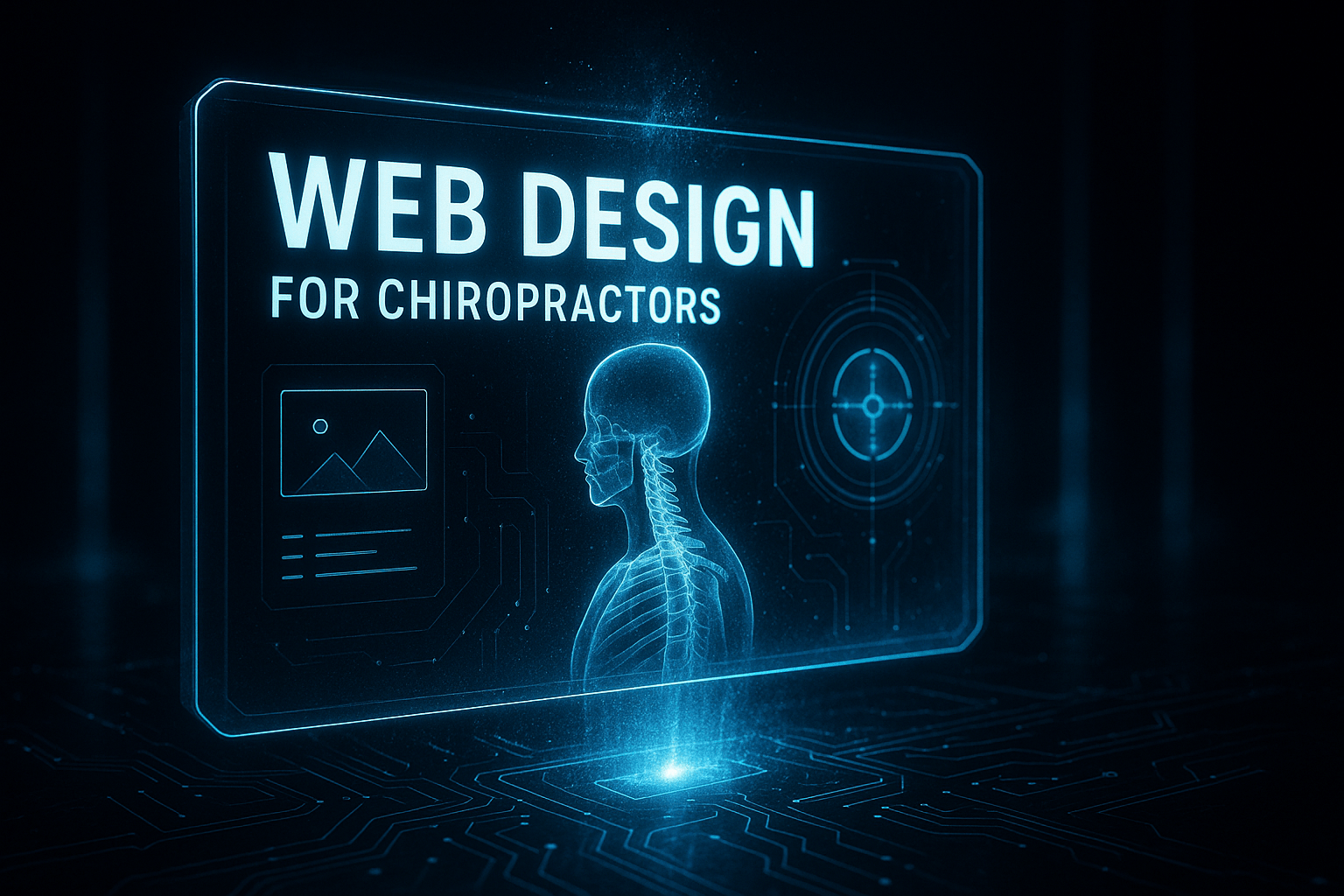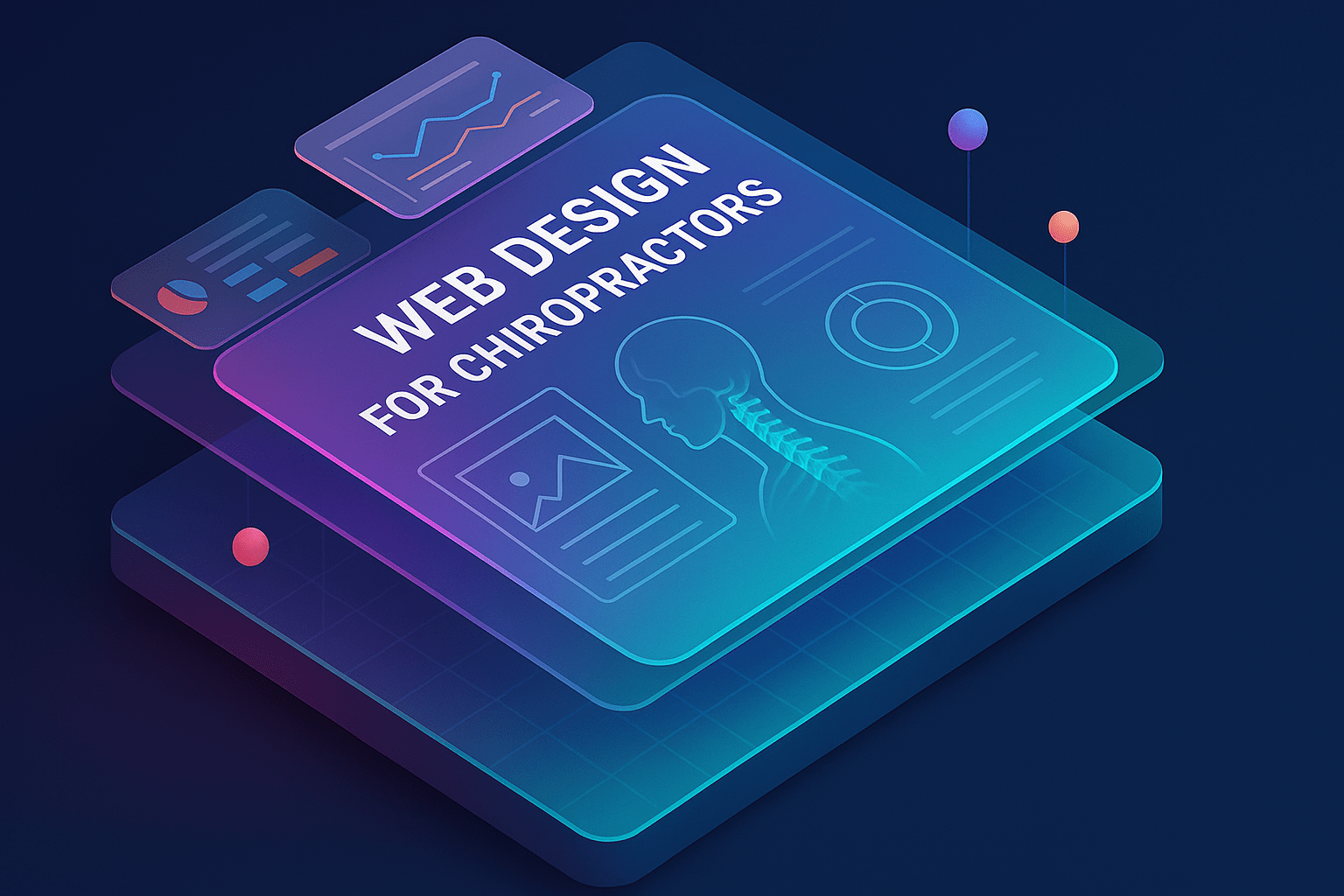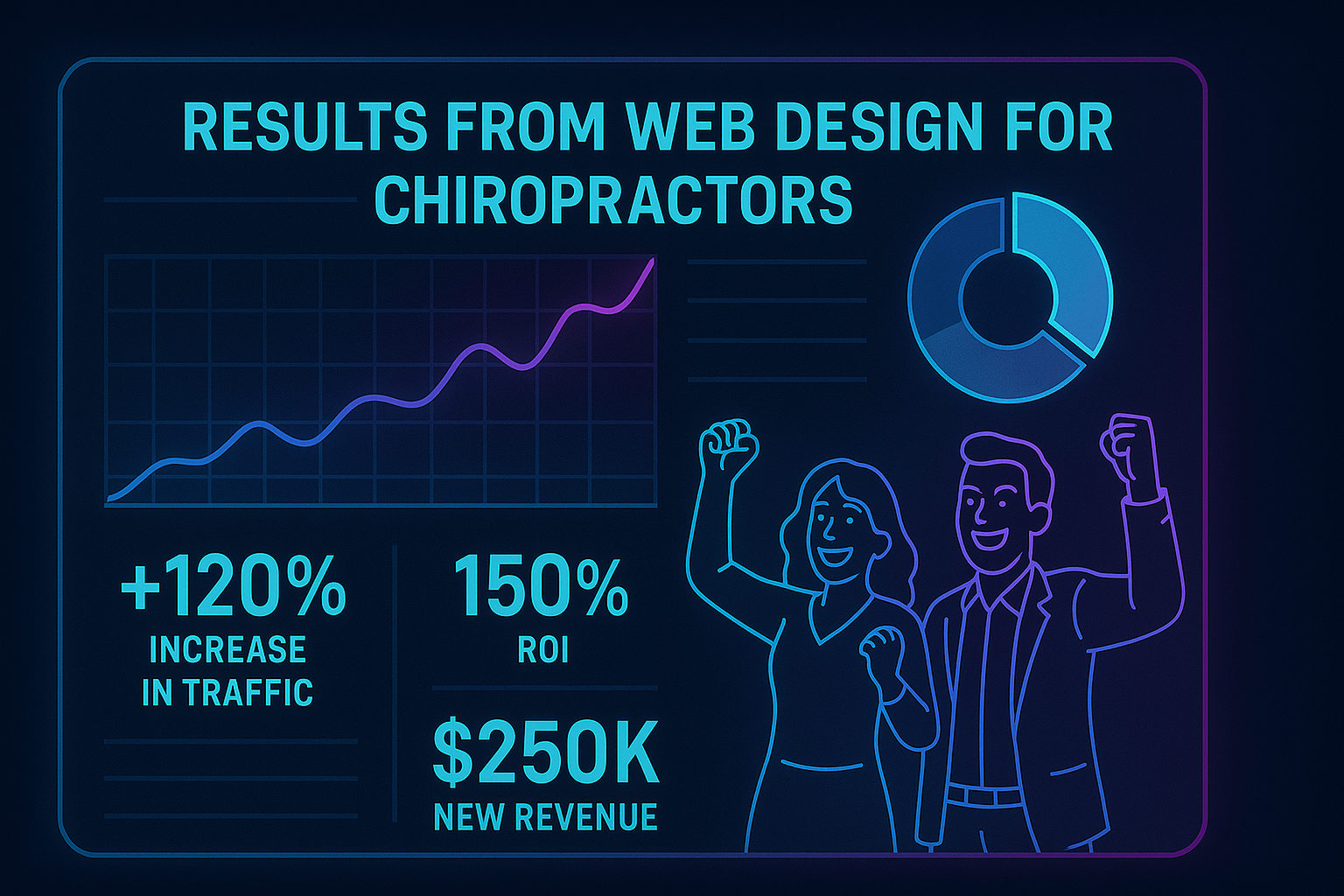Web Design for Chiropractors: Complete 2026 Strategy Guide
by Design Delulu Editorial · October 9, 2025

Smart, fast, and measurable. Here's how web design helps Chiropractors win.
Your chiropractic website isn't just a digital business card—it's your most powerful patient acquisition tool. In 2026, potential patients research chiropractors online before ever picking up the phone, comparing credentials, reading reviews, and evaluating whether your practice feels trustworthy. A well-designed website builds that trust instantly, communicates your expertise clearly, and converts visitors into booked appointments. Without strategic web design, you're losing patients to competitors who understand the digital-first healthcare landscape.
The stakes are higher than ever. Modern patients expect fast-loading pages, mobile-friendly experiences, and clear pathways to booking. They want to understand your treatment approach, see proof of results, and feel confident you can solve their pain problems—all within seconds of landing on your site. Generic templates and outdated designs send the wrong message. Strategic web design for chiropractors combines conversion psychology, local SEO optimization, and patient-centered messaging to transform your website from a passive brochure into an active growth engine for your practice.

Why Chiropractic Practices Need Specialized Web Design
Healthcare websites operate under different rules than typical business sites. Patients arrive with pain, anxiety, and skepticism—they need reassurance before they need features. Your website must establish clinical credibility while remaining warm and approachable. This balance requires specialized design thinking that understands patient psychology, HIPAA considerations, and the unique competitive dynamics of local chiropractic markets.
Generic web design fails chiropractic practices in three critical ways:
- Trust deficit: Stock photos of models pretending to be patients destroy authenticity. Real patient outcomes, actual team photos, and genuine testimonials build the credibility needed to convert skeptical visitors.
- Confusing journeys: Patients don't understand medical jargon. Clear explanations of conditions you treat, transparent pricing information, and simple booking paths remove friction from the appointment process.
- Local invisibility: Chiropractors serve geographic areas. Without proper local SEO integration—location pages, schema markup, Google Business Profile optimization—your beautiful website remains invisible to the patients searching in your area.
Specialized web design for chiropractors addresses these gaps systematically. It prioritizes patient education over medical terminology, emphasizes outcomes over techniques, and structures content around the patient's journey from pain to relief rather than your services list.
Core Elements of High-Converting Chiropractic Websites
Effective chiropractic web design balances multiple priorities: clinical authority, patient comfort, conversion optimization, and search visibility. Here's how the essential elements work together to create a patient acquisition system:
Strategic Homepage Design
Your homepage has one job: help visitors self-identify and take the next step. Lead with the outcome patients want—relief from back pain, improved mobility, drug-free treatment—not your credentials. Follow with clear service categorization by condition (sciatica, sports injuries, auto accidents) or patient type (athletes, families, seniors). Include prominent booking CTAs, trust signals (years in practice, patient count, certifications), and a compelling reason why your approach works when others haven't.
Condition-Specific Landing Pages
Patients search for solutions to problems, not for chiropractors. Create dedicated pages for each condition you treat:
- Lower back pain treatment
- Neck pain and headache relief
- Sports injury recovery
- Auto accident care
- Pregnancy chiropractic
- Pediatric adjustments
Each page should explain symptoms, your treatment approach, expected outcomes, and include a booking form. This structure captures long-tail search traffic and speaks directly to patient concerns with relevant messaging.

Trust-Building Content Architecture
New patients are risk-averse. They need multiple trust signals before booking:
- Video testimonials: Real patients describing their journey from pain to relief provide social proof that written reviews cannot match.
- Before/after case studies: Document specific patient outcomes with measurable improvements (pain scales, range of motion, activity restoration).
- Provider bios with personality: Skip the resume format. Share why you became a chiropractor, your treatment philosophy, and what patients say makes your approach different.
- Educational content: Blog posts, videos, and guides that answer common questions position you as the trusted authority while improving SEO.
- Transparent pricing: Even if you can't list exact prices, explain your pricing model, insurance acceptance, and payment options to remove cost anxiety.
Conversion-Optimized Booking Systems
Every design decision should reduce friction in the appointment path. Make booking ridiculously easy:
- Place booking CTAs in the header, sidebar, and end of every page
- Offer multiple contact methods—online forms, phone, text, chat
- Integrate with scheduling software for instant confirmation
- Create a new patient welcome sequence that addresses common concerns
- Enable mobile click-to-call for immediate phone contact
Consider adding a triage quiz that asks about symptoms, duration, and previous treatments, then recommends the appropriate service—this personalizes the experience and qualifies leads automatically.
Mobile-First Responsive Design
Over 65% of healthcare searches happen on mobile devices. Your chiropractic website must perform flawlessly on smartphones:
- Touch-friendly buttons: Large tap targets for calls, directions, and booking
- Compressed images: Fast loading times even on cellular connections
- Simplified navigation: Hamburger menus with clear hierarchy
- Click-to-call prominence: Phone numbers that initiate calls instantly
- Vertical scrolling optimization: Long-form content that flows naturally on narrow screens
Technical Foundation: Speed, Security, and Search
Beautiful design means nothing if your website doesn't load quickly, rank well, or protect patient privacy. The technical foundation matters as much as visual aesthetics.
Core Web Vitals Optimization
Google prioritizes fast, stable websites in search results. Core Web Vitals measure user experience through three key metrics:
- Largest Contentful Paint (LCP): Main content should load within 2.5 seconds. Optimize hero images, use modern formats (WebP), and implement lazy loading.
- First Input Delay (FID): Pages should respond to interactions within 100ms. Minimize JavaScript, defer non-critical scripts, and optimize third-party integrations.
- Cumulative Layout Shift (CLS): Visual stability prevents content from jumping during load. Reserve space for images and ads to prevent layout shifts.
Achieving excellent Core Web Vitals scores improves both search rankings and conversion rates—fast sites keep impatient patients engaged.
Local SEO Architecture
Chiropractors compete in local markets. Your website must signal geographic relevance:
- Location-specific pages: If you have multiple offices, create unique pages for each location with distinct content, reviews, and booking options.
- Schema markup: Implement LocalBusiness, MedicalBusiness, and Review schema to help search engines understand your practice details.
- NAP consistency: Ensure your Name, Address, and Phone number match exactly across your website, Google Business Profile, and directory listings.
- Embedded Google Maps: Help patients find you easily and reinforce location signals to search engines.
- Local keywords: Include neighborhood names, nearby landmarks, and geographic modifiers throughout content naturally.
HIPAA Compliance Considerations
While websites themselves aren't covered under HIPAA, your contact forms and patient portals must protect health information:
- Use SSL certificates (HTTPS) for all pages
- Encrypt form submissions and stored data
- Include privacy policies that explain data handling
- Obtain consent before using patient testimonials or photos
- Use HIPAA-compliant email services for patient communication
- Select hosting providers with proper security measures
Accessibility Best Practices
Accessible websites serve more patients and avoid legal risks. Follow WCAG 2.1 guidelines:
- Color contrast: Ensure text is readable against backgrounds (4.5:1 ratio minimum)
- Keyboard navigation: All interactive elements must work without a mouse
- Alt text: Describe images for screen readers thoroughly
- Form labels: Associate labels with inputs properly
- Heading hierarchy: Use H1-H6 tags in logical order
- Video captions: Provide transcripts for audio content

Content Strategy for Patient Acquisition
Great design showcases great content. Your content strategy should educate patients, build authority, and capture search traffic across the patient journey.
Educational Blog Strategy
Publish content that answers patient questions at every stage:
- Awareness stage: "Why does my lower back hurt when I wake up?" "Is cracking your neck dangerous?" "How long does sciatica last?"
- Consideration stage: "Chiropractor vs. physical therapist for back pain" "What happens during your first chiropractic visit?" "How many adjustments will I need?"
- Decision stage: "Choosing a chiropractor in [City]" "What to ask before your first adjustment" "Insurance coverage for chiropractic care"
Publish consistently—weekly if possible. Long-form guides (1,500+ words) outperform short posts. Include personal insights from your clinical experience. Optimize each post for a specific keyword and link to relevant service pages.
Video Content Integration
Video builds trust faster than text. Create short videos showing:
- Office tours that reduce new patient anxiety
- Adjustment demonstrations with patient consent
- Exercise tutorials for home care
- Provider introductions that showcase personality
- Patient testimonial interviews
- Myth-busting content addressing misconceptions
Embed videos throughout your site and on service pages. Transcribe videos for SEO benefits and accessibility.
Social Proof Strategy
Display reviews prominently and strategically:
- Feature top reviews on your homepage with photos
- Create a dedicated testimonials page with filtering by condition
- Embed Google reviews widget for real-time social proof
- Showcase patient counts, years in practice, and awards
- Include before/after stories with measurable outcomes
Actively request reviews from satisfied patients through automated email sequences post-visit.
Implementation Process and Timeline
Building a high-performing chiropractic website follows a structured process designed to minimize disruption while maximizing results.
Phase 1: Discovery and Strategy (Week 1-2)
We start by understanding your practice, patients, and goals:
- Competitive analysis: Review top-ranking competitor websites, identify gaps and opportunities
- Patient research: Survey existing patients about what influenced their choice, common questions, pain points
- Analytics audit: Examine current website data to identify high-performing content and drop-off points
- Keyword research: Map search intent to patient journey stages, prioritize conditions you treat
- Goal setting: Define success metrics—appointment bookings, form submissions, call volume, organic traffic
Deliverables include a comprehensive strategy document, sitemap, and measurement framework.
Phase 2: Design and Content (Week 3-4)
Visual design and content development happen in parallel:
- Wireframing: Create low-fidelity layouts focusing on user flow and conversion paths
- Design system: Establish color palette, typography, component library aligned with your brand
- High-fidelity mockups: Design homepage and key templates for review
- Content creation: Write service pages, provider bios, condition guides, and foundational blog posts
- Photography planning: Schedule office photos, staff headshots, and patient testimonial shoots
You'll review designs and content, provide feedback, and approve direction before development begins.
Phase 3: Development and Integration (Week 5-6)
Development transforms designs into a functioning website:
- Front-end build: Code responsive templates using modern frameworks
- CMS configuration: Set up WordPress, Webflow, or your preferred platform with custom fields
- Integration work: Connect scheduling software, review platforms, analytics tools, and email marketing
- Technical SEO: Implement schema markup, optimize site speed, configure redirects, submit sitemap
- Content population: Add all written content, images, videos, and forms
Phase 4: Testing and Launch (Week 7-8)
Thorough testing prevents launch issues:
- Cross-browser testing (Chrome, Safari, Firefox, Edge)
- Mobile device testing (iOS and Android)
- Form submission testing and notification verification
- Speed testing and Core Web Vitals validation
- Broken link checking and redirect verification
- Accessibility audit with automated and manual testing
- Analytics and tracking implementation verification
After your approval, we launch the new site with monitoring in place to catch any immediate issues.
Phase 5: Optimization and Growth (Ongoing)
Launch is the beginning, not the end. Monthly optimization drives continuous improvement:
- Review analytics to identify high-exit pages and optimization opportunities
- A/B test headlines, CTAs, and form designs
- Publish new blog content targeting additional keywords
- Update service pages based on patient questions
- Expand condition-specific landing pages
- Refresh testimonials and case studies regularly
Measuring Success: Key Performance Indicators
Track metrics that directly impact practice growth, not vanity metrics:
Primary Conversion Metrics
- New patient appointments: The ultimate measure—track source (organic, direct, referral) to optimize channels
- Form submissions: Contact forms, consultation requests, new patient intake forms
- Phone calls: Use call tracking to attribute calls to specific campaigns and pages
- Booking conversion rate: Percentage of visitors who schedule appointments
Patient Acquisition Funnel
- Organic traffic: Growth in visitors from search engines month-over-month
- Keyword rankings: Position for target terms in local search
- Click-through rate: Percentage of searchers who click your listing in results
- Bounce rate: Percentage who leave immediately (lower is better)
- Time on page: Engagement depth on key pages
- Pages per session: How much visitors explore your site
Technical Performance
- Core Web Vitals scores: LCP, FID, CLS all in "good" range
- Page load time: Under 3 seconds for all pages
- Mobile usability errors: Zero issues in Google Search Console
- Uptime percentage: 99.9% availability minimum
ROI Calculation
Calculate website ROI by tracking:
- New patients from website: Use intake forms to ask how patients found you
- Average patient lifetime value: Multiple visit revenue plus referrals
- Website investment: Design, development, hosting, and maintenance costs
- Return calculation: (New patient value - Website cost) / Website cost × 100
Even a modest improvement in new patient acquisition typically generates 5-10x returns on website investment within the first year.
Common Mistakes to Avoid
Learn from these frequent chiropractic website failures:
Design Mistakes
- Stock photo overload: Generic images scream "template site." Use authentic photos of your actual practice and team.
- Confusing navigation: Complex menus frustrate users. Keep primary navigation to 5-7 items maximum.
- Hidden contact information: Make phone numbers and booking CTAs prominent on every page.
- Auto-playing videos: Annoying visitors drives them away immediately. Always require user initiation.
- Cluttered layouts: White space improves comprehension. Don't cram everything above the fold.
Content Mistakes
- Medical jargon: Patients don't understand technical terminology. Write for 8th-grade reading level.
- Service-focused copy: Talk about patient outcomes, not your techniques. They care about results, not methods.
- Missing social proof: Testimonials and reviews reduce risk. Feature them prominently throughout the site.
- Weak CTAs: "Contact us" is passive. Use action-oriented language: "Schedule Your Relief Consultation."
- No local relevance: Generic content doesn't rank locally. Include neighborhood names and local landmarks.
Technical Mistakes
- Slow loading: Patients abandon slow sites. Optimize images and minimize scripts ruthlessly.
- Poor mobile experience: Tiny text and buttons frustrate mobile users. Test extensively on actual devices.
- No analytics: You can't optimize what you don't measure. Install comprehensive tracking from day one.
- Broken forms: Test form submissions regularly and ensure notifications work correctly.
- Neglecting security: Sites without SSL certificates lose trust and search rankings. Maintain security updates.
Future-Proofing Your Chiropractic Website
Build for today while anticipating tomorrow's needs:
AI and Chatbot Integration
Intelligent chatbots can answer common questions 24/7, qualify leads, and schedule appointments automatically. Look for solutions that handle:
- Symptom triage and service recommendations
- Insurance and payment questions
- Appointment scheduling and rescheduling
- New patient paperwork collection
Voice Search Optimization
As voice assistants grow, optimize for conversational queries:
- Target question-based keywords ("who," "what," "where," "how")
- Create FAQ pages with natural language answers
- Claim and optimize Google Business Profile for voice results
- Focus on local intent ("chiropractor near me")
Telehealth Capabilities
Integrate virtual consultation options for initial assessments, follow-ups, and wellness coaching. Ensure your platform meets HIPAA requirements for video communication.
Patient Portal Integration
Modern patients expect digital convenience:
- Online appointment scheduling and management
- Digital intake forms and health history updates
- Access to treatment plans and exercise videos
- Secure messaging with your practice
- Payment processing and receipt access
Personalization and Automation
Use marketing automation to deliver relevant content:
- Welcome sequences for new subscribers
- Appointment reminders and preparation instructions
- Post-visit follow-up with home care instructions
- Educational content based on treatment type
- Re-engagement campaigns for inactive patients
Working with a Web Design Partner
Choosing the right web design team significantly impacts your results. Look for partners who understand chiropractic practice marketing specifically, not just generic healthcare or small business websites.
What to Look For
- Healthcare portfolio: Review their previous chiropractic or medical website projects. Ask about results achieved.
- Strategic thinking: They should ask about your goals, patients, and competition before discussing design.
- Technical expertise: Verify they understand SEO, Core Web Vitals, accessibility, and modern development practices.
- Content capabilities: Can they create compelling copy and visual content, or just design?
- Ongoing support: Website success requires continuous optimization. Ensure they offer maintenance and growth services.
- Clear communication: Do they explain technical concepts clearly? Can you understand their process and timeline?
Investment Ranges
Chiropractic website costs vary based on scope and customization:
- Template-based sites: $3,000-$8,000—faster launch, limited customization, may not include strategic content
- Semi-custom sites: $8,000-$20,000—balanced approach with some custom design and strategic content development
- Fully custom sites: $20,000-$50,000+—completely unique design, extensive content, advanced integrations, strategic consulting
Consider ongoing costs: hosting ($20-200/month), maintenance ($100-500/month), content creation ($500-2,000/month), and SEO services ($1,000-5,000/month).
Questions to Ask Before Hiring
- What chiropractic websites have you designed? Can I see results data?
- How do you approach content creation and SEO?
- What's your process and timeline from kickoff to launch?
- How will we communicate throughout the project?
- What happens after launch? Do you offer ongoing optimization?
- How do you handle revisions and feedback?
- What platforms do you recommend and why?
- How will you integrate with my existing practice management software?
- What metrics will you track to measure success?
- Who owns the website files and can I take them to another developer if needed?
Getting Started: Your Action Plan
Ready to transform your chiropractic website? Follow this roadmap:
Immediate Actions (This Week)
- Audit your current site: Run it through Google PageSpeed Insights, check mobile usability, review Google Search Console for errors
- Survey patients: Ask 10-20 recent patients how they found you and what influenced their decision to book
- Review competitors: Examine the top 5 chiropractic websites in your area. What do they do well? Where are gaps?
- Define goals: Set specific targets—number of new patients, organic traffic growth, or booking conversion rate improvements
- Gather assets: Collect high-quality photos, patient testimonials, credentials, and any existing content
Short-Term Actions (This Month)
- Research design partners: Request proposals from 3-5 qualified web design agencies or freelancers
- Establish budget: Determine what you can invest in design, development, and ongoing optimization
- Map patient journey: Document the steps from first search to booked appointment. Where does your current site fail?
- Keyword research: Use tools like Google Keyword Planner to identify what patients search for in your area
- Content planning: Outline pages needed, blog topics to cover, and video content to produce
Long-Term Strategy (Next 3-6 Months)
- Launch new website: Complete design, development, and initial content population
- Implement tracking: Set up comprehensive analytics, call tracking, and conversion measurement
- Begin content publishing: Establish weekly blogging rhythm targeting patient questions
- Build review pipeline: Create systems to request and showcase patient testimonials
- Optimize based on data: Monthly reviews of performance with continuous A/B testing and improvements
- Expand content: Add new condition pages, video content, and downloadable resources
Your website is the foundation of your digital presence. Invest in strategic design, create patient-focused content, optimize relentlessly, and watch your practice grow through sustained patient acquisition. The chiropractors who win in 2026 and beyond understand that exceptional web design isn't an expense—it's the most profitable marketing investment you can make.
Frequently Asked Questions
Let’s level up your Chiropractors business
Need services that actually move the needle for Chiropractors? See our approach, pricing, and timelines—then book a quick call.
Additional Resources
- Schedule Your Strategy Session
Book a free 30-minute consultation to discuss your chiropractic practice goals, current website challenges, and explore how strategic web design can increase patient acquisition. No sales pressure, just honest guidance.
- View Our Healthcare Design Portfolio
Explore our complete collection of chiropractic and healthcare website projects. See real-world examples of patient-focused design, conversion optimization, and local SEO implementation that drove measurable practice growth.
- Access Free Website Tools
Try our free website audit tool, keyword research templates, and patient survey questionnaires. Get actionable insights to improve your current site while you plan your redesign strategy.
Related Reading

Transform your vacation rental website with conversion-focused design. Discover proven strategies, booking optimization, and responsive layouts that increase direct reservations.

Discover how strategic web design helps cleaning companies attract customers, showcase services, and convert website visitors into loyal clients. Proven design strategies inside.
